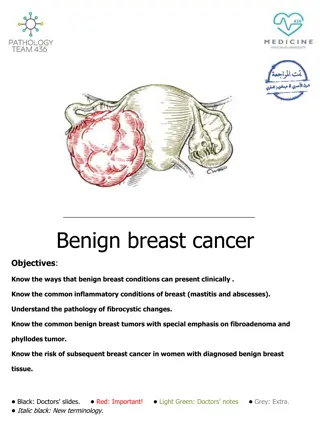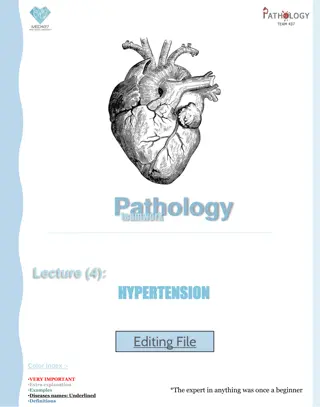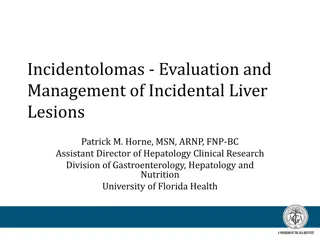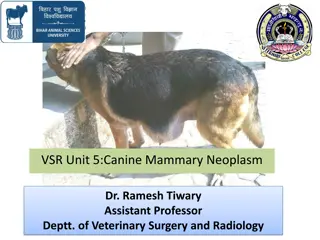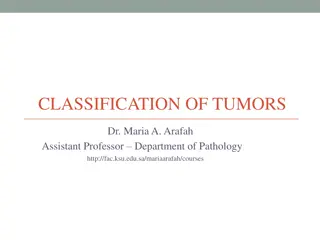Overview of Benign Diseases of Vulva: Anatomy, Classification, and Assessment
This comprehensive guide provides insights into benign diseases affecting the vulva, including anatomy details, classification of disorders, and assessment methods used in patient evaluation. Explore information on vulvar intraepithelial neoplasia, common symptoms, and the importance of history-taking and clinical examination. Gain a better understanding of managing vulval conditions for optimal patient care.
Download Presentation

Please find below an Image/Link to download the presentation.
The content on the website is provided AS IS for your information and personal use only. It may not be sold, licensed, or shared on other websites without obtaining consent from the author.If you encounter any issues during the download, it is possible that the publisher has removed the file from their server.
You are allowed to download the files provided on this website for personal or commercial use, subject to the condition that they are used lawfully. All files are the property of their respective owners.
The content on the website is provided AS IS for your information and personal use only. It may not be sold, licensed, or shared on other websites without obtaining consent from the author.
E N D
Presentation Transcript
BENIGN DISEASES OF BENIGN DISEASES OF VULVA VULVA DR. DR.Alaa Alaa Ibrahim Ibrahim
ANATOMY: -The vulva is the area of the perineum including the Mons pubis, labia majora and minora and the opening into both the vagina and urethra . -The vulval vestibule is the area between the lower end of the vaginal canal at the hymenal ring and the labia minora, bartholin gland is the major glands of the vestibule and lie deep within the perimeum.
Classification of vulval disorders: Benign lesions of the vulva are mentioned in three categories: 1. Epithelial conditions (Non neoplastic Vulvar Dermatoses ). 2. Benign neoplastic disorders. 3. Dermatological disorders.
Vulvar intraepithelial neoplasia (VIN): -Sequamous vaginal intraepithelial neoplasil VIN1(mild dysplasia) VIN2(moderate dysplasia) VIN3(sever dysplasia)or carcinoma in situ. -Non sequamousVIN Pagets disease
ASSESSMENT OF PATIENTS WITH VULVAL DISEASE: -Vulvar skin is more permeable than surrounding tissues because of differences in structure, hydration, and susceptibility to friction . -As a result, pathology involving the vulva is common.
1- taking history: - focus on the presenting complaint. -current methods of skin care. -topical treatments are being used. -the impact of symptoms on the sexual function. -personal and family history of autoimmune disease, atopic conditions (asthma, hay fever). -any symptoms of urinary or faecal incontinence(irritating to the skin (
2-Clinical examination of vulval area with good light source. 3- vulval swabs to exclude infection as a cause of vulval symptoms. 4 -consider testing for thyroid disease, diabetes if clinically indicated. 5. Skin biopsy : is required if the woman fails to respond to treatment or there is clinical suspicion of VIN or cancer.
Common vulval symptoms : 1. vulval pruritus: The term pruritus vulvae properly refers to vulvar irritation for which no cause can be found , is commoner in older women and is most frequently encountered after the age of 40 years. - infection, candidiasis, trichomonas vaginalis. -Skin conditions, Lichen sclerosis, VIN. -contact dermatitis.
2. vulval pain: -infection, candidiasis. -Skin conditions, Lichen sclerosis, VIN. -Vulvodynia. 3. Superficial dyspareunia: -Skin conditions , Lichen sclerosis -Vulvodynia -Vulval fissures. -Skin bridges of vulva.
1. Non neoplastic Vulvar Dermatoses : Classification by International Society for the Study of Vulvar Disease( ISSVD) based on both histopathologic and gross changes. 1.Squamous cell hyperplasia( Lichen Simplex Chronicus). 2. Lichen sclerosus 3.Lichen planus. 4. Other dermatoses: Bullous lesions, Ulcerative lesions
1-Squamous Cell Hyperplasia (Lichen Simplex Chronicus): - It is local thikening of the epithelium resulting from chronic truma secondary to prolonged itching or scratching as a protective response of the involved skin. presents with pruritis and pain. Signs- whitish or reddish thickened, leathery, raised surface, usually discrete but may be multiple.
- Triggering factors, including chemical substances contained within hygiene products and topical medicines . -Treatment: topical steroid ointment help to reduce inflamation, where as lubricants help to restore the skin s barrier function.If symptoms fail to resolve within one week to resolve within 1 to 3 weeks, biopsy is indicated to exclude other pathology.
2-Lichen Sclerosus Is a common chronic inflammatory progressive skin disease that predominantly affects the anogenital skin. In long term labia minora are lost, labia majora flattened .clitoris becomes inverted. classically presents in postmenopausal women, but can be seen in children and younger females.
the cause remains unknown, but genetic, infectious, hormonal, and autoimmune etiologies have been suggested. association with thyroid disease , pernicious anemia , diabetes. an increased risk of vulvar malignancy squamous cell carcinoma, occurring in about 4-6 %.
Symptoms: vulvar pruritus -induced scratching creates a vicious cycle leading to excoriations and further thickening of the vulvar skin. Dyspareunia, burning pain. Signs: thin inelastic atrophic skin, white with a crinkled, tissue paper appearance. -The characteristic clinical picture and histologic confirmation typically lead to the diagnosis revealed a thin atrophic epithelium with inflammatory cells lining the basement membrane
Treatment: -Vulvar hygiene -Topical potent Corticosteroids, clobetasol propionate once nightly for 4 weeks, followed by alternating nights for 4 weeks, and finally tapered to twice weekly for 4 weeks. long term therapy with low potent steroids may be nessesory.
3. lichen planus: -Is an inflammatory disease that involves both cutaneous and mucosal surfaces, equally affects men and women between age 30 and 60 year. It is purplish, polygonal , papules that may appear in their erosive form. - It involves vulva, the vagina, the mouth( vulval vaginal- gingival syndrome). - -Unknown cause but it is likely believed to be related to T-cell related autoimmunity to basal keratinocyte. -
-Symptoms and signs-vulval burning, chronic vaginal discharge ,sever dyspareunia when vaginal stenosis develop in advanced stages. -Treatment-topical and systemic steroids.
-Causes of benign vulvar ulcer: Aphthous - Herpes genitalis - -syphilis Crohn disease - Lymhpogranulomavenerum - Chancroid - Donovanosis - Tuberculosis Any persistent ulcer should be biopsied to exclude malignancy.
2. Bening neoplastic conditions A. fibroma : are the most common solid tumors that arise in the deeper connective tissue of the vulva, they are slow growing 1-10 cm , but may become huge, treated by excision.
B-lipomas Lipomas-slow growing tumors , composed of adipose cells, treated by excision.
3. Dermatological conditions: 1.psoriasis: appears velvety ,but lacks the characteristics scaly patches found on the knee and elbow. 2.Behcet syndrome: ulcers in the vulval, oral , ocular areas, genital lesions can result over time in a scarred vulva, diagnosis based on the concurrence of ulcers in vulva, mouth, and ocular involvement, the recurrent nature of the disease,and exclusion of syphilis and crohns disease
3.Crohns disease: vulval ulcers can precede the development of the GIT ulcerations. They are slit like or knife cut ulcers with prominent edema. Drianing sinuses and fistula to the rectum may occur. 4.Acanthosis negricans: most commonly occur in the axilla or thenape of the neck then the vulva, charectarised by darky pigmented velvetyor warty surface, the cause usually related to insulin resistance.
VULVAL INTRAEPITHELIAL NEOPLASIA It is a premalignant conditions which is increasing in incidence. -Sequamous cell carcinoma in situ : VIN 3 can be unifocal or multifocal. Typically, multifocal VIN 3 presents with small hyperpigmented lesions on the labia majora . Some cases of VIN 3 extending to the posterior fourchette and involving the perineal tissues.
-The term bowenoid papulosis (bowenoid dysplasia) has been used to describe multifocal VIN lesions ranging from grade 1 to 3. Clinically, patients with bowenoid papulosis present with multiple small pigmented papules (40% of cases) that are usually less than 5 mm in diameter. -Most women with these lesions are in their 20s, and some are pregnant. After childbirth, the lesions may regress spontaneously. -Can be either associated with HPV( can occur in premenopausal women) or with lichen sclerosis( in potmenopausal women) ,mean age is 45 years.
50% asymptomatic, and if symptoms occur , the most common is itching. Most lesions are elevated and white , red ,pinch, brown, or grey in colour. 20% of lesions are warty in appearance . Diagnosis by:-carefule inspection of the vulval area under light and with the aid of magnifying glass. 5%acetic acid is applied the after 2 minute VIN turn white and mosaic , or punctuation may be visible. Adequate biobsy to rule out invasive disease
Treatment: - -Spontaneous regression of VIN3 in women with the variant known as bowenoid papulosis is well describe. -The treatment originally recommended for CIS of the vulva was wide excision, fears that the disease frequently was preinvasive led to the widespread use of superficial vulvectomy . -Because progression is relatively uncommon, typically occurring in 5% to 10% of cases , extensive surgery is not warranted.
- -Excision of small foci of disease produces excellent results- local exicion with the margins of 5mm are adequate -The carbon dioxide laser can be used for multifocal lesions but is unnecessary for unifocal disease. The disadvantages are that it can be painful and costly and does not provide a histopathologic specimen . -Superficial vulvectomy is appropriate to treat extensive and recurrent VIN 3 . Split- thickness skin grafts can be harvested from the thighs or buttocks.
-Adenocarcenomas in situ VIII(pagetes disaes): Occur in white postmenopausal women , in the vulval , nipple area of the breast. 20% associated with adinocarcinoma. Itching and tenderness are common, appears likewell demarcated , eczematus , with white plaque like lesions. Gowth may progresses beyond vulva to the mons pubis , buttock , and thighs.
Diagnosis :histologicaly charctarized by large , pale, pathognomonic page'ts cells, typically located in the epidermic and in the adeneaxal structures. Treatment: -Local superficial exision with the margins 5-10 mm. -Lazer therapy in reccurrences which are common.
Thank you Thank you






